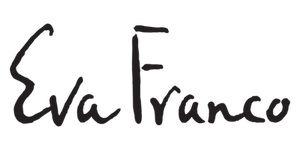Safety Meets Fashion: Benefits of Eva Franco Masks
Posted by EVA FRANCO
A good mask means a piece that is stylish, colorful, comfortable, washable, and, above all, safe. I loved the challenge of blending fashion and safety together to create face masks that people actually wanted to wear. Pieces to make customers smile (even if the smile is hidden behind the mask). A safe mask requires several components. It’s important to me to create products that not only look good, but also protect people during these very turbulent times. For me, a safe mask requires comfort, style, and the important things -- like a snug fit around the face, nose and mouth coverage, and the right quality of fabrics.

Adjustable straps for a tight fit
Let’s begin with elastic. There are many different types of elastic out there. They are a key part of making sure your mask fits your face, not just an afterthought. Straps also need to be comfortable if you plan to wear your mask for any length of time. As I discovered, it takes more than a quick loop of elastic to have truly useful and wearable straps. According to researchers at the University of Chicago and Argonne National Laboratory, mask edges should be fitted close to your face.
I decided to use a round, quarter-inch elastic and created straps with stoppers because I wanted personalized adjustment for my customers. Small sliders on the elastic bands on my masks allow you to quickly tighten or loosen the mask to your face. I also realized, after spending one day wearing sunglasses, earrings, earbuds, and a mask, what a burden my poor ears have now! I had to create an alternative (but still stylish, of course) method to attach masks. The adjustable straps on my mask allow them to be connected to my signature headbands and baseball hats for ear-free mask wear. I also have a new product that’s a plastic piece that connects the straps towards the back of the head, which decreases the stress on the ears.
Keeping the mask edge closed, especially around the nose bridge, is another key feature for a truly safe fit. The University of Chicago and Argonne Labs researchers also noted that air gaps “affect the efficiency of any face mask”. I created a small pleat at the nose bridge with a flexible nose wire inside the seam. The wearer can simply pinch the nose wire and seal the air gap at the top of the mask. It’s a basic element, but so very important at preventing unfiltered air flow through the top of the mask.
Mask Material
Material, of course, is a critical consideration. The best material doesn’t sacrifice comfort for safety. The extensive laboratory testing done by the folks at Smart Air has shown that tightly woven cotton allows for breathability and filtration. Smart Air is a commercial entity, but who knows filtration technology better than the people who actually make air purifiers and air quality monitors? I chose a multi-layered cotton fabric, with a second, inner cotton lining. This provides a dual layer of breathable protection and allows the mask to be worn for an extended period of time without irritating delicate faces.
Mask material has another important consideration. Masks get contaminated with each wear. Besides bacteria and viruses, makeup, lotions, oils from your skin, and other products can end up on the inside of the mask. According to the U.S. Centers for Disease Control and Prevention, cloth face masks should be washed after each use. A mask made with all natural material means you can quickly hand wash it at the end of the day and start fresh the next day.
Face Mask Filters
You’ll notice that my masks include a small pocket on the inside. For the most effective protection, wear the cloth mask with a filter. Not all filters are equal when it comes to effectiveness. Filters that can stop fine, airborne particles (PM 2.5 size particles for you science lovers out there) are the gold standard. The carbon filters available through my store can be easily tucked into the interior pockets for added protection. More importantly, they capture the fine PM 2.5 particles.

How to use a mask
It’s easy, right? Just tuck the loops around your ears and make sure the mask covers your nose and mouth? Turns out there are a few more safety steps when it comes to proper wear and handling of a mask.
- Wash your hands before putting the mask on.
- Touch only the exterior of the mask (or only the ear loops).
- Make sure there are no air gaps between the mask and your face.
- Cover both your nose and mouth with the mask.
- Take your mask off using only the ear loops. Wash your hands after handling the mask.
A mask is only part of the overall safety measures required. Take these additional steps recommended by the World Health Organization.
- Maintain a physical distance of at least one meter (3 feet) from other people.
- Wash your hands often.
- Stay at home as much as possible.
- Try not to touch your eyes, nose, or mouth.
- Cough or sneeze into your elbow or a tissue.
Of course, I know my masks are being made to my specifications. They are manufactured with sustainable fabrics right here in California at my Los Angeles atelier.
We are excited to bring you more protection with our hats with face visors and mask ear extenders.
Stay safe. Stay stylish.
Eva


